
Click to read the piece on substack (this is also how I share summaries of my reseach - and will post many more things in the future) open.substack.com/pub/ksechkar...
01.11.2025 11:30 — 👍 0 🔁 0 💬 0 📌 0@ksechkar.bsky.social
DPhil Engineering Science student at Oxford Uni. All opinions are my own, but the risk you take by reading them is yours Other soc. media: http://cosoc.com/KSechkar

Click to read the piece on substack (this is also how I share summaries of my reseach - and will post many more things in the future) open.substack.com/pub/ksechkar...
01.11.2025 11:30 — 👍 0 🔁 0 💬 0 📌 0
Thrilled to have attended this week's iGEM Jamboree - full of amazing teams, brilliant research and indomitable SynBio optimisim
But even if you couldn't come, you can still watch me embarass myself by trying to write it up as a satirical sketch (link in the next post)
So how can we reframe 'balancing innovation with safety'? Well, it's still vital to *innovate safely* and have robust regulation, but I'd say we also have the responsibility to *innovate FOR safety* - and this premise is baked into the idea of Engineering Biology itself 6/6
29.04.2025 14:32 — 👍 0 🔁 0 💬 0 📌 0Identifying these behaviours, we can then design biosystems with robustness, safety and reliability in mind (e.g. that's what our ongoing @eebio.bsky.social
programme is all about). Innovative stuff, but hardly pitted against safety! 5/6
Using automatic culturing platforms, we work to characterise biotechnologies' behaviours as they're affected by factors like randomness, evolution or (my own area of interest) the sheer interconnectedness and complexity of living systems - so they won't catch us by surprise 4/6
29.04.2025 14:32 — 👍 0 🔁 0 💬 1 📌 0I, for one, am doing a PhD supervised by Prof Harrison Steel at the Oxford Control Group. Just like EngBio's name would suggest, we approach problems in *biology* with principles from control *engineering* - which include precisely robustness, predictability and safety! 3/6
29.04.2025 14:32 — 👍 0 🔁 0 💬 1 📌 0One common point in these discussions is the need to 'balance innovation with safety'. Fair! As mentioned in the debate, one mishap can tarnish the field's reputation for good, so robust regulation is vital. But why do we often frame innovation and safety as opposites? 2/6
29.04.2025 14:32 — 👍 0 🔁 0 💬 1 📌 0Exciting times in UK EngBio governance!
-Debate on the House of Lords' EngBio report (we submitted evidence for that, wow!) shorturl.at/bJHUE
-New Science & Technology framework shorturl.at/cZkGG
-EngBio Aspirations Report shorturl.at/F9dj0
Won't post all my precious thoughts, but hope one is OK 1/6

NEW PREPRINT! Do you think we can do better when characterising resource competition properties of gene circuit modules? If no, think again; if yes, you’re in for a pitch how exactly we can do that – automated culturing, cybergenetic control and all! 1/
doi.org/10.1101/2025...
Thanks to my supervisor Prof Harrison Steel , as well as to our collaborators from @eebio.bsky.social - Sara Brancato, Prof Lucia Marucci and Dr Ludovic Renson for advice. They’re also working on exciting applications of CBC right now, so watch them closely (what a time to be alive!) 9/9
04.04.2025 09:22 — 👍 1 🔁 0 💬 0 📌 0For now, this is more of a pitch with an in silico proof-of-concept, but we discuss which developments in SynBio and control will help us apply this protocol in vivo. Briefly, advanced control algorithms + single-cell culturing + optogenetics = fun 8/
04.04.2025 09:22 — 👍 2 🔁 1 💬 1 📌 0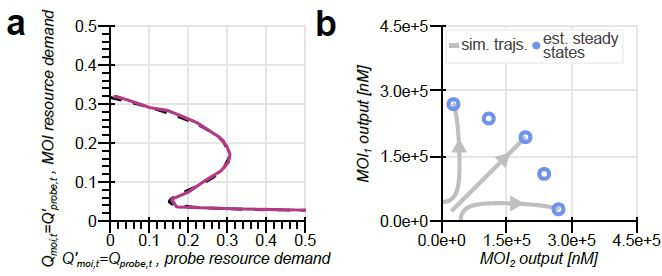
We successfully simulate our protocol using different models of various complexities (e.g. see results for a mechanistic resource-aware cell model in the pic below) – gives us reason to think it should work in (even more complex) real cells! 7/
04.04.2025 09:22 — 👍 1 🔁 0 💬 1 📌 0
From start to finish, our proposed method involves first establishing the probe’s properties, then using it to do CBC with the genetic module of interest. The results can then predict how any two characterised modules will compete for resources! 6/
04.04.2025 09:22 — 👍 1 🔁 0 💬 1 📌 0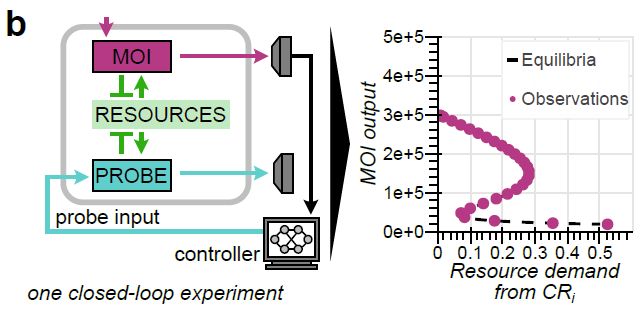
Here, the module of interest’s output is its fluorescent gene expression, and the feedback input is e.g. chemical induction of another ‘probe’ genetic module competing with it for resources 5/
04.04.2025 09:22 — 👍 1 🔁 0 💬 1 📌 0We suggest using control-based continuation (CBC), where a stabilising external feedback input drives a system through the entire range of its equilibria! 4/
04.04.2025 09:22 — 👍 1 🔁 0 💬 1 📌 0
Yet arugably, multistability & bifurcations are the most fun bit! And we know resource competition may cause them (and sometimes that’s even leveraged by circuit designs like our recent Punisher doi.org/10.1098/rsif... ). So characterisation of competition should include them… What should we do? 3/
04.04.2025 09:22 — 👍 1 🔁 0 💬 1 📌 0
To gauge resource demands, we often look at how modules compete for gene expression resources with constitutive fluorescent reporter genes. But there’s a problem: in multistable systems, constant resource competition may drive your system to just one steady state among many possible
04.04.2025 09:22 — 👍 1 🔁 0 💬 1 📌 0
NEW PREPRINT! Do you think we can do better when characterising resource competition properties of gene circuit modules? If no, think again; if yes, you’re in for a pitch how exactly we can do that – automated culturing, cybergenetic control and all! 1/
doi.org/10.1101/2025...
Hope I’ve gotten you interested enough to go and read our paper for details! And the best way I can conclude is by thanking the editors & reviewers, @Harrison_Steel for supervision and coauthorship, and @Andreas_Porse and other Steel Lab members for their great advice! 10/10
12.02.2025 12:53 — 👍 1 🔁 0 💬 0 📌 0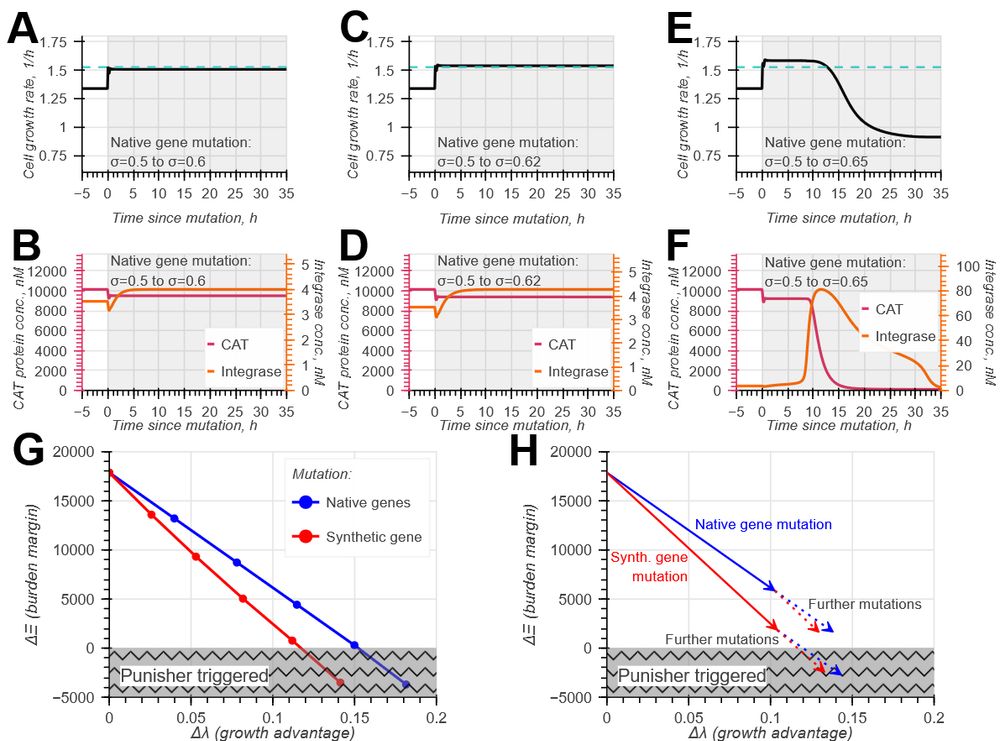
We also consider beneficial *native* gene mutations. For the same growth advantage, these are less prone to triggering the Punisher than synthetic gene loss, yielding better fitness. Clonal interference can thus help to hinder engineered cell populations’ function loss 9/10
12.02.2025 12:53 — 👍 1 🔁 0 💬 1 📌 0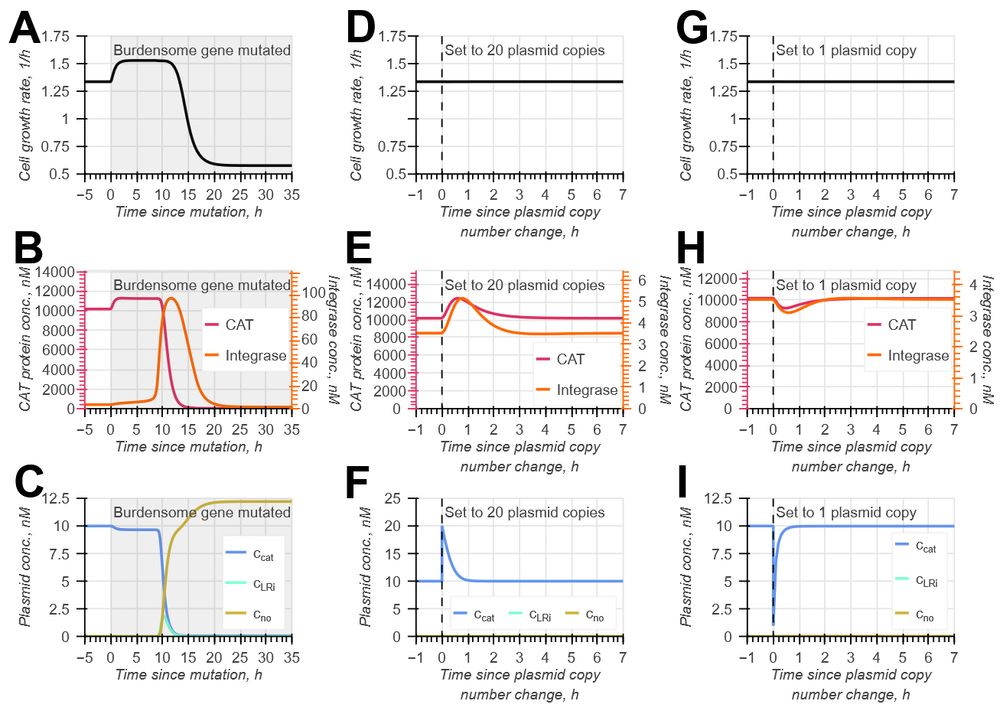
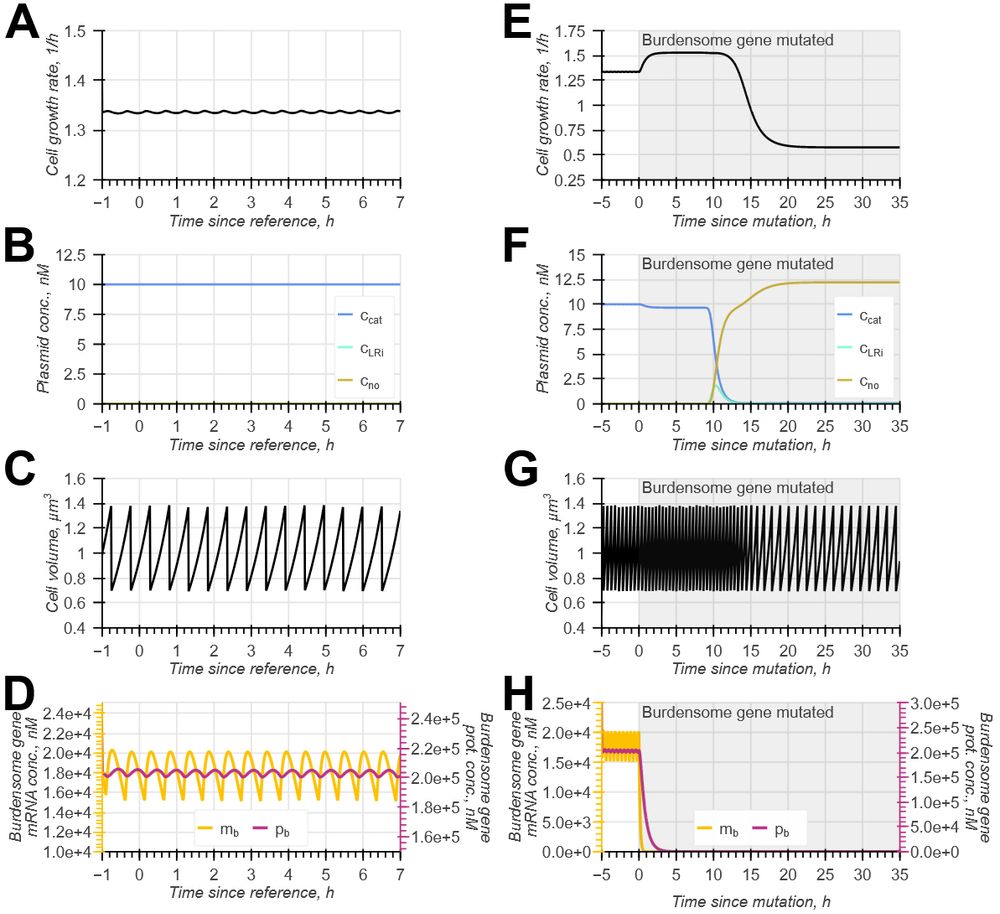
How about transient reductions in burden due to uneven plasmid and cell cycle fluctuations? We can likewise model these to show that the Punisher is robust to such disturbances 8/10
12.02.2025 12:53 — 👍 1 🔁 0 💬 1 📌 0
Though the Punisher’s aimed at penalising mutations of genes burdening the cell primarily via resource competition, we also model metabolic burden. Turns out, our design can punish mutations of metabolically burdensome genes, too – just tune the chemical induction again! 7/10
12.02.2025 12:53 — 👍 1 🔁 0 💬 1 📌 0What’s new since the preprint? We now simulate many more scenarios beyond those just showcasing the Punisher in action! Beyond just studying our circuit, we believe our approaches could generally come in handy for resource-aware modelling of single cells and populations 6/10
12.02.2025 12:53 — 👍 1 🔁 0 💬 1 📌 0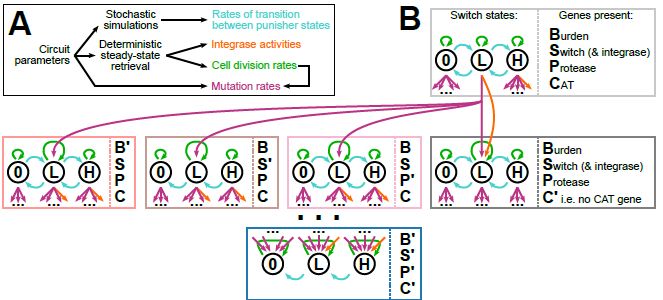

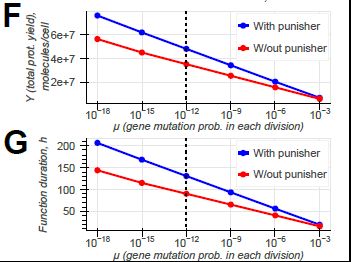
We also define a population model based on deterministic and stochastic simulations, directly linking physiological parameters of synthetic genes and circuit performance on a populational level. Our model shows the Punisher really is helpful in settings like bioreactors 5/10
12.02.2025 12:53 — 👍 1 🔁 0 💬 1 📌 0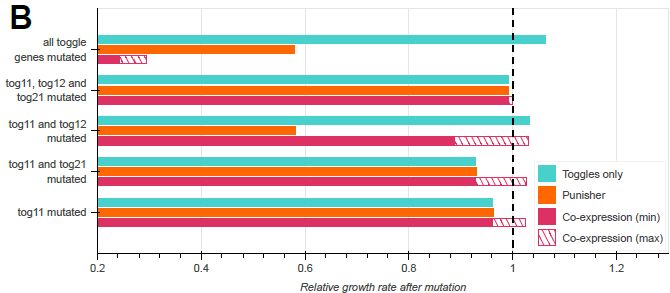
Direct sensing of burden gives the Punisher an edge over extant designs (like co-expression of essential genes with synthetic genes of interest), which may accidentally encourage mutant cell growth through unintended responses 4/10
12.02.2025 12:53 — 👍 1 🔁 0 💬 1 📌 0

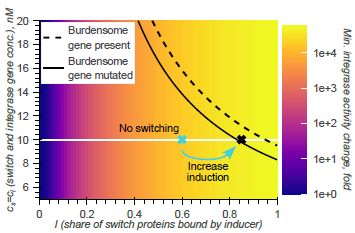
Thanks to a self-activating switch, the Punisher’s triggered by burden reduction (eg by mutations) and excises an essential gene. The switching threshold can be tuned by chemical induction, so it can be reused for many applications without any long & costly DNA engineering 3/10
12.02.2025 12:53 — 👍 1 🔁 0 💬 1 📌 0Recapping our preprint: by competing for cellular resources, the synthetic genes make host cells burdened & slow-growing, so mutants that lose these genes outgrow useful cells in a population. But our ‘Punisher’ gene circuit can sense burden & hinder mutant cell growth 2/10
12.02.2025 12:53 — 👍 1 🔁 0 💬 1 📌 0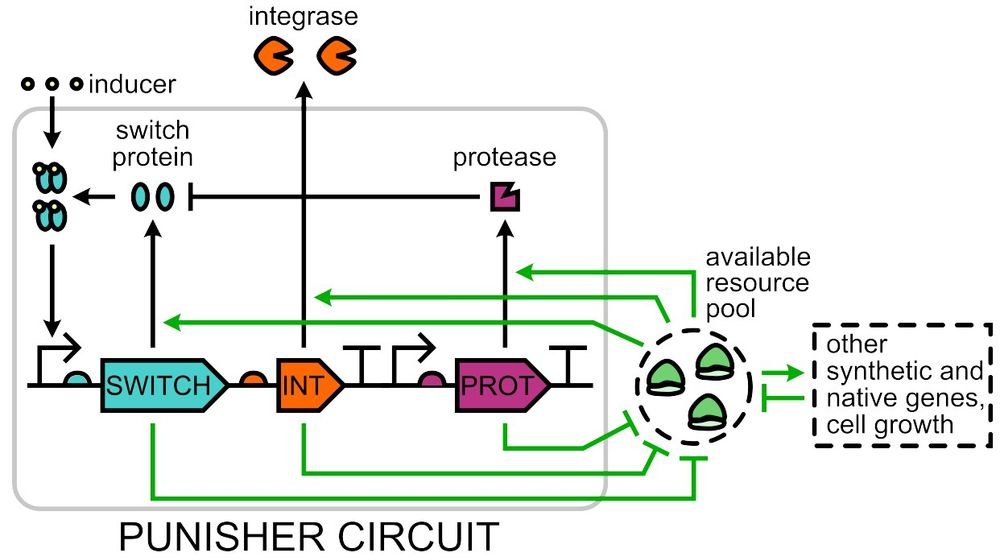
Our paper on countering mutations in engineered cell populations has now been published with @royalsocietypublishing.org ! Come for our biomolecular controller that mitigates mutation spread, stay for resource-aware gene circuit design and modelling tools 1/10
doi.org/10.1098/rsif.2024.0602
Many thanks to my supervisor Prof Harrison Steel, as well as my fellow contributors @vicente-trelles.bsky.social , Ting An Lee, Jessica James, Marco Corrao, Lisa Zillig and @scottstacey.bsky.social !
15.01.2025 12:25 — 👍 3 🔁 0 💬 0 📌 0
Great to see the points highlighted by our lab’s submission – such as the need for long-term funding and developing robust standards – in the House of Lords Engineering Biology report! The work to make the UK a leader has been astutely laid out, now let’s get going
tinyurl.com/33xuh2er